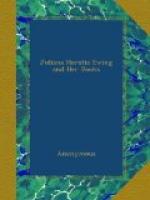This allusion was only a slight one, but Julie wrote a complete story on one species of Trillium, having a special affection for the whole genus. Trilliums are amongst the North American herbaceous plants which have lately become fashionable, and easy to be bought in England; but ere they did so, Julie made some ineffectual attempts to transplant tubers of them into English soil; and the last letter she received from Fredericton contained a packet of red Trillium seeds, which came too late to be sown before she died. The species which she immortalized in “The Blind Hermit and the Trinity Flower,” was T. erythrocarpum. The story is a graceful legend of an old Hermit whose life was spent in growing herbs for the healing of diseases; and when he, in his turn, was struck with blindness, he could not reconcile himself to the loss of the occupation which alone seemed to make him of use in the world. “They also serve who only stand and wait” was a hard lesson to learn; every day he prayed for some Balm of Gilead to heal his ill, and restore his sight, and the prayer was answered, though not in the manner that he desired. First he was supplied with a serving-boy, who became eyes and feet to him, from gratitude for cures which the Hermit had done to the lad himself; and then a vision was granted to the old man, wherein he saw a flower which would heal his blindness:—
[Illustration: TRILLIUM ERYTHROCARPUM.]
“And what was the Trinity Flower like, my Father?” asked the boy.
“It was about the size of Herb Paris, my son,” replied the Hermit. “But, instead of being fourfold every way, it numbered the mystic Three. Every part was threefold. The leaves were three, the petals three, the sepals three. The flower was snow-white, but on each of the three parts it was stained with crimson stripes, like white garments dyed in blood.”
A root of this plant was sent to the Hermit by a heavenly messenger, which the boy planted, and anxiously watched the growth of, cheering his master with the hope—“Patience, my Father, thou shalt see yet!”
Meantime greater light was breaking in upon the Hermit’s soul than had been there before:
“My son, I repent
me that I have not been patient under affliction.
Moreover, I have set
thee an ill example, in that I have murmured
at that which God—Who
knoweth best—ordained for me.”
And, when the boy ofttimes
repeated, “Thou shalt yet see,” the
Hermit answered, “If
God will. When God will. As God will.”
And at last, when the white bud opens, and the blood-like stains are visible within, he who once was blind sees, but his vision is opened on eternal Day.




